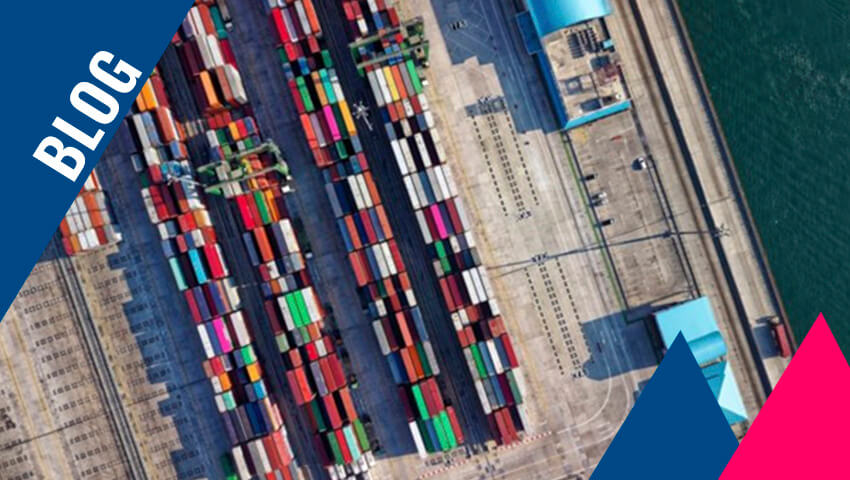
Predictive modelling can get you the goods on time
We currently live in a world of constrained resources, growing populations and climate emergencies that indicate that humans are exceeding the planetary boundaries placed on them as a species. If critical tipping points are reached, our very survival is at stake. Make no mistake, however, life on this planet will continue to thrive; it is just that we humans will not be around to enjoy it.
In the high risk environment of COVID-19, only 13 percent of global companies have total visibility of their extended supply chains according to estimates by KPMG Australia – and that’s a problem when high demand times are on the horizon.
- 80+ percent of supply chain leaders want tracking tools to enable real-time reporting.
- Only 13 percent have complete visibility into the end-to-end supply chain.
Supply chain expert Peter Liddell, KPMG Partner in Charge of Asia Pacific Supply Chain Advisory, says that a lack of visibility – together with the high risk choke points in key parts of the goods and services supply chain caused by COVID – will lead to shortages of high demand goods into Australia during peak trading periods.
“With disruption of supply chains – especially in air freight – getting imported foods into the country is vital. The coming holiday season highlights the importance of forward planning,” he says. “We do have a solution: a powered supply chain with predictive modelling capability providing visibility that can cover an organisation and its extended value chain to help manage through periods of supply disruptions caused by crises like COVID.”
He said that right now, KPMG is experiencing heightened demand for integrated supply chain risk management solutions.
“Fortunately, there are cost-effective digital solutions available to help domestic supply chains successfully navigate these challenges,” Mr Liddell said. “These are Artificial Intelligence (AI) enabled digital solutions which can help a company by drawing upon internal and external data sources to predict risks and disruptions before they occur.”
Peter Liddell said that, in doing so, these tools help businesses to assess the operational, financial and reputational impacts of future supply chain risks – and take advantage of best-practice process architectures, embedding robust operational controls. This can allow businesses to anticipate and quickly respond to supply continuity problems.
Using AI to protect enterprise value, KPMG’s Supply Chain Predictor – just launched to market -is a state-of-the-art cloud based AI tool used to predict and mitigate operational risks and disruptions before they are likely to occur. It also enables simulation of alternative supply chain strategies through a ‘digital twin’ to assess the potential impact of any adjustment made within the extended supply chain
“Data driven insights help predict supply chain risk and disruption,” said Mr Liddell. “The ‘digital twin’ is the most spoken phrase in every corporate at present. In Supply Chain terms, it refers to the ability to simultaneously showcase the existing supply chain model next to the future supply chain – Predictor has this capability and clients who see the demo love it – many technologies speak about it – but very few currently have the capability.”
He emphasised that Supply Chain Predictor was ideally suited to the Australian and global agribusiness sectors including horticulture.
“As an example, the use of predictive analytics to sense biosecurity outbreaks for enhanced biosecurity management and proactively protect Australia’s agribusiness industry can provide local companies with a significant advantage,” he said. “Predictive management can assist in a range of industries.”
‘Human-based systems cannot absorb the level of data that an AI system can absorb. The evidence out of the deployment of these systems is that they are more accurate and their ability to absorb and analyse data is highly sophisticated. They can link changes and pick up challenges that humans don’t or can’t.’
Another key example is the ability a predictive supply chain tool has to tap into global trends including geopolitical developments enabling a bigger and more detailed picture of a local industry. The wine industry is a typical example of an area which can benefit from predictive data.
1. KPMG Supply Chain Predictor – industry use-cases
Agribusiness Key Benefits
- Biosecurity Data– can connect biosecurity data, legacy government departmental data, and industry data with non-traditional and big data sources for surveillance across any mapped agribusiness supply chain (to identify the presence of threats and define when they can be most effectively addressed)
- Exotic Pests– can help proactively respond to the increasing number, scale and scope of exotic pests and disease threats across Australia which threaten one of Australia’s largest export industries.isis Events – can predict risk events, with alerts sent to farmers in advance of biosecurity outbreaks to mitigate the impact of threats to Agribusiness.
“What’s more, from paddock to plate, KPMG is seeing strong demand for a cloud-based solution to help agribusinesses sense supply chain issues before they occur,” Peter Liddell said.
This includes:
- Advanced notification– confirming delays in product arriving at markets/stores (impact on customer).
- Issues alerts– capturing issues with product quality (fresh, cold chain compliance) through the supply chain.
- Changing orders– sensing shifts in customer ordering patterns (fresh to frozen, in-store to on-line) and fulfilment requirements (pick up at store to delivery at home) and predicting the impact on ‘last mile’ logistics requirements to support customer fulfilment.
- Demand surges– detecting demand surges in key markets (domestic and export) and predicting supply shortages based on known product availability.
Life Sciences / Healthcare Key Benefits
Mr Liddell said using predictive analystics supply chain management techniques was also ideally suited to the healthcare and medical business sector.
“It can provide full visibility across the extended value chain to key stakeholders,” he said. “This allows them to better understand how the current stockpile of medical inventories and inbound supplies can (or will not) meet current demand expectations for critical medical supplies across the country, by state, by hospital.”
Benefits of predictive analytics for this sector included:
- Advanced notification– confirming supply issues ahead of event thus leading to faster response times to mitigate the impact of critical events.
- Loss minimisation– helping to minimise lost sales due to production shutdowns or insufficient goods for sale in key markets.
- Disruption management– advance warning (vs restrospective warning) of network, supply or demand disruptions. Supply Chain operators can drill into the early warnings (supply disruptions or demand variations) at any level (product, raw material, customer, supplier, transport node etc) in order to proactively mitigate the impacts of supply chain failure.
2. Current Supply Chain Risks
Mr Liddell characterised the current key risks in the Australian supply chain as including:
- Challenged sea freight logistics planning– Ample sea freight container space for. outbound/export only but KPMG notes that not all products are suited to this type of freight.
- Strong demand but rising costs for air freight– air freight is a rare transport commodity due to COVID at less than 10 percent of normal capacity per IFAM.
- Further air feight pressures ahead – KPMG predicts precious freight space and costs will create pressure in the market leading up to Christmas 2020.
- Commodity demand vs scarcity– KPMG says demand for prawns reflects supply chain risk issues with Australia reliant on 70 percent imported from China and Thailand. This too, will come under pressure for peak Christmas period.
“In 2020, we’ve seen the COVID-19 outbreak and other related events significantly impact global supply chains – resulting in some severe consequences,” said Peter Liddell. “Predictive Supply Chain Management solutions provide “AI powered” views of the extended supply chain and operations. What’s being asked for in the marketplace is a Supply Chain Risk Management Solution to help predict the risk events, define the impacts of such disruptions to air and sea freight – as well as to road and rail – and enable cross functional rapid scenario planning capability to support agile decision making.”
Mr Liddell said new generation supply chain technology will sense risks and visualise issues by leveraging internal and external data and use the advanced capabilities of AI to define optimum course of actions based on trade-off analysis by simulating various business scenarios and help busineses to avoid or minimise operational and financial impact.
“KPMG’s predictive supply chain management solution (Predictor) addresses risk challenges facing supply chains by using a real time digital platform that utilises advanced predictive analytics,” he said.
3. KPMG Supply Chain Predictor
- Ingests and integrates data from a company’s internal supply chain systems and interfaces with many external data sources showing real time events (Natural Disaster, News Feeds, Geopolitical, Supplier Financials, Regulatory)
- Enables real time predictive analysis of risk events and determines potential supply chain risk exposure
- Allows users to model and simulate cross functional supply chain scenarios to evaluate business impact for making trade-off decisions to avoid or minimise impact (revenue vs. cost vs. service levels)
- Recommends mitigation activities based on financial impact and risk avoidance scenarios through an AI-based logic
- Enhances operational and financial performance by applying insights from customers, suppliers, third party providers and other external data points.
- Improves decision-making and interoperability through holistic and transparent supply chain platform.
“KPMG’s view is that it has become vital to deliver increased collaboration with all supply chain and trading partners through increased collaboration, the sharing of data and by adopting real time connectivity,” said Peter Liddell. “Supply chain performance can be quickly improved by moving planning from historical data usage – and more towards predictive analytics.”
He said that the benefits of a proactive management approach using a ‘powered’ or ‘predictive’ supply chain tool included fewer incidents signicantly impacting operations and a downstream decrease in waste consumption as well as notable increase in customer fulfilment rates. Most importantly, the customer experience is not negatively impacted and in some cases we have seen service delivery performance enhance dramatically.
“Automated reporting with predictive capabilities can show risk profiles and how they change over time,” said Mr Liddell. “Looking ahead, we also see opportunities in supply chain technology innovation such as the advanced digital traceability of goods which, once embedded, can feed into predictive modeling and further help the analytic capabilities used by these risk management solutions.”
-KPMG Australia
